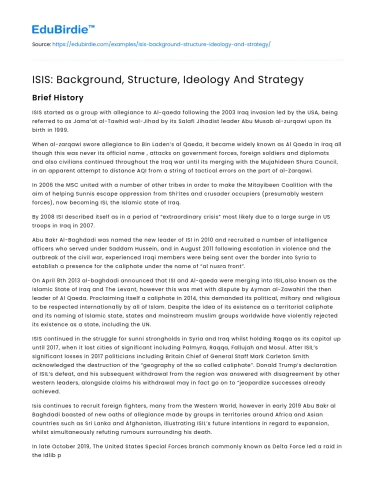Introduction
The Islamic State of Iraq and Syria (ISIS), also known as Daesh, has emerged as a significant entity in global terrorism, infamous for its brutal tactics and radical ideology. Originating from the ashes of Al-Qaeda in Iraq, ISIS has managed to capture global attention and instigate fear through its sophisticated operations and media-savvy strategies. Understanding ISIS's background, structure, ideology, and strategy is crucial for comprehending its impact on international security and regional stability. This essay explores these aspects, shedding light on how ISIS has evolved into one of the most formidable terrorist organizations of the 21st century. By examining its historical context, organizational hierarchy, core beliefs, and strategic objectives, this analysis aims to provide a comprehensive overview of ISIS and its implications. Furthermore, engaging with counterarguments and alternative perspectives will offer a nuanced understanding of this complex entity.
Background and Organizational Structure
ISIS traces its origins to the aftermath of the 2003 U.S.-led invasion of Iraq, which destabilized the region and gave rise to various insurgent groups. Initially an offshoot of Al-Qaeda, ISIS gained notoriety under the leadership of Abu Bakr al-Baghdadi, declaring a caliphate in 2014. It capitalized on the power vacuum and sectarian tensions in Iraq and Syria, recruiting members through promises of jihad and a return to early Islamic governance. The organization’s structure is hierarchical, with the caliph at the apex, followed by a Shura council, regional emirs, and military commanders. This centralized leadership allows for coordinated operations and strategic planning across its territories.
Save your time!
We can take care of your essay
- Proper editing and formatting
- Free revision, title page, and bibliography
- Flexible prices and money-back guarantee
ISIS’s ability to maintain control over large swathes of land can be attributed to its bureaucratic governance model, which includes departments for finance, education, and media, among others. This mimicry of state functions not only legitimizes its authority but also facilitates resource management and recruitment. A key feature of ISIS's organizational prowess is its adept use of modern technology, particularly social media, to disseminate propaganda and recruit globally. However, critics argue that ISIS’s rigid hierarchy is also its Achilles' heel, as the loss of key leaders could disrupt its operational capabilities. Despite this, ISIS has proven resilient, adapting its tactics to maintain relevance even after significant territorial losses.
Ideology and Strategic Objectives
The ideology of ISIS is rooted in a radical interpretation of Sunni Islam, advocating for a return to a pure form of governance as practiced by the Prophet Muhammad and his immediate successors. This extremist worldview is characterized by takfir, the act of declaring other Muslims as infidels, which justifies ISIS’s violent actions against those it deems apostates. The group’s ultimate aim is the establishment of a global caliphate, governed by Sharia law, which necessitates the obliteration of borders and the unification of the Muslim ummah under its rule.
Strategically, ISIS employs a combination of conventional warfare, terror tactics, and psychological operations to achieve its objectives. Its military strategy involves swift territorial acquisitions, often executed with shock and awe tactics, leveraging both conventional arms and asymmetric warfare techniques. Furthermore, ISIS utilizes terror attacks outside its immediate territories to project power and instill fear, exemplified by the attacks in Paris, Brussels, and beyond. The strategic use of media to broadcast these acts serves to amplify their impact, drawing recruits and funding while spreading its ideology. However, the group's reliance on extreme violence has also alienated potential allies and drawn significant international military opposition, challenging its long-term viability.
Counter-Arguments and Adaptation
While ISIS presents itself as a formidable force, several counter-arguments suggest potential vulnerabilities within the organization. Critics highlight the inherent unsustainability of ISIS’s governance model, which relies heavily on coercion and brutality. This approach often leads to internal dissent and resistance from local populations, undermining its claims of providing a just and stable Islamic state. Additionally, the global coalition against ISIS, comprising military, financial, and ideological efforts, has significantly curtailed its territorial reach and operational capabilities.
Adaptation has been a key element of ISIS's survival strategy, as it has shifted focus from territorial control to inspiring lone-wolf attacks globally. This decentralization of operations makes it harder to predict and counteract, allowing the group to maintain influence despite losing territory. Nonetheless, the lack of a centralized base and diminished recruitment capabilities pose significant challenges to its long-term strategic objectives. The ongoing counter-terrorism efforts, coupled with the ideological pushback from mainstream Islamic scholars, further diminish ISIS’s appeal and recruitment pool. Thus, while ISIS remains a threat, its capacity to achieve its grandiose objectives is increasingly constrained by both internal and external pressures.
Conclusion
In conclusion, ISIS represents a complex challenge, rooted in a volatile mix of political instability, radical ideology, and strategic opportunism. Its rise, characterized by a unique blend of traditional and modern warfare tactics, has reshaped the landscape of global terrorism. Despite facing substantial setbacks, ISIS's adaptability and ideological resilience allow it to persist as a significant threat. The international community must continue to address the underlying socio-political issues that fuel such extremism while countering ISIS’s narrative through both military and ideological means. As the world grapples with the evolving threat of ISIS, understanding its intricate dynamics remains essential for formulating effective countermeasures and ensuring long-term peace and stability.






 Stuck on your essay?
Stuck on your essay?

